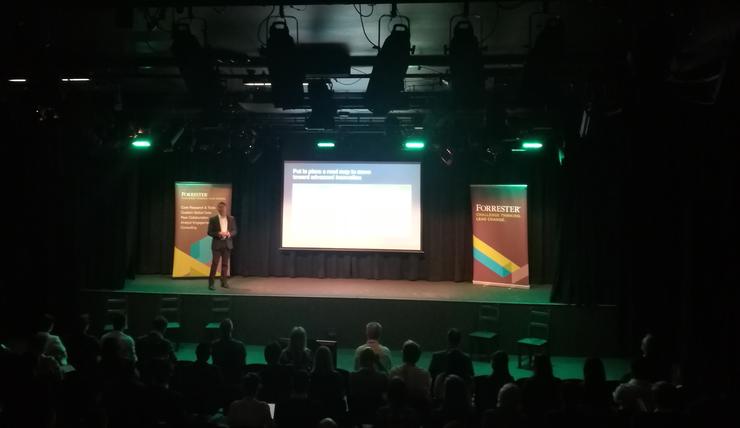
Michael Barnes
One in four CIOs will expand their remit in 2019 and become true owners of digital business and technology-led innovation, leaving the rest relegated to trusted IT operators.
That’s one of a host of predictions made by analyst research firm, Forrester, as part of its annual 2019 predictions round-up released this week. Speaking at an event to mark the launch, Forrester VP and research director of digital strategy, Michael Barnes, anticipated a dramatic shift in the role of the CIO over the course of the next year.
“We expect to see CEOs and CIOs mutually agree that the CIO needs to take ownership for driving digital business innovation, and technology-led innovation within the firm,” he told attendees. “It’s time for CIOs to step up.”
This is because the number one priority for firms globally in 2018 is to invest in emerging technologies, Barnes said. A recent Forrester survey shows technology is considered the key source of finding new value streams.
“As a result, 25 per cent of CIOs will expand their remits, and take more control over digital business. The rest will be relegated to a trusted operator and ensure trains run on time,” Barnes said. “While this is an important function, it’s not core to driving continuous innovation and seeking new sources of value, which is critical from a competitive standpoint for all firms today.”
To get to the top of the strategic tree, CIOs must align innovations and initiatives to strategic goals set forth in annual business planning sessions, Barnes said. They also should rely on vendors as much as they can for innovation IP as a stepping stone, and move towards continuous planning and improvement.
“We’ve seen the move to agile approaches, devOps and more iterative processes. What we’re not seeing and what we need to see is making that more consistent across the entire technology function,” he said.
At an intermediate level, there’s still a need to adopt a more formal process for evaluating emerging technology, Barnes said, to help better articulate the value of things like Internet of Things or artificial intelligence for the organisation. It’s also about embracing platform-based innovation more effectively.
Then it’s about moving towards tech-driven business innovation, using technology to deliver business value. “At a fundamental level, that requires the people evaluating the technology to be business leaders,” Barnes said.
“You also need to seed innovation in the firm. A good example is example agile and devOps into the product teams, and treating the firm more as a ‘software’ firm.
“We’re also starting to see firms looking to invest in startups and drive innovation in particular areas.”
2019: The year of digital transformation reckoning
Forrester has previously referred to 2018 as “the year of reckoning”. In his lead-in to the 2019 predictions, Barnes described this year as one where external forces compelled all organisations to embrace digital transformation and customer experience changes.
“We saw that urgency take off throughout the year,” he said. “But what we also saw is urgency is nowhere near enough; firms have faced significant headwinds through the year.”
A big one is organisational readiness to embrace change, while another is a lack of continuous and clear executive support. A third is fear digital transformation and innovation initiatives will impact existing sources of revenue.
As a result, Forrester is sizing up 2019 as the “year when transformation goes pragmatic”. The firm predicts organisations will increasingly pivot from enterprise-wide, strategic transformations to far more targeted initiatives that are better measured and monitored for results and value.
“The positive with this focus on pragmatism is it will allow firms to put in place the foundational elements necessary to drive change, and overcome some of the legacy systems and technical debt in place, and data governance challenges,” Barnes said.
“The challenge is it potentially gives folks the incorrect belief that the status quo is OK and that organisational inertia is OK, and that you don’t need to push to overcome that.
“The bottom line is if firms are able to target pragmatic initiatives and investments in 2019 towards the foundational requirements necessary to drive sustainable change, they will be in great shape to invest in more value generating transformational initiatives in the years to follow.”
Forrester’s research shows digital transformation continues to dominate business decision making, Barnes continued. At the same time, the overwhelming majority of firms remain in the ‘beginner’ or ‘intermediate’ stages of transformation.
He also noted 66 per cent of Australian firms state that they’re undergoing digital transformation right now. Alarmingly, however, 17 per cent believe they’ve completed it.
“This is an issue and highlights the challenge we’re facing,” Barnes continued. “There’s this confusion over what digital transformation actually means. The reality is you don’t finish, it’s continuous.
“The reason a lot of respondents are confused is that they’re thinking in terms of low hanging fruit, such as the customer-facing issues they think they’ve addressed, and digital engagement. But many haven’t done the second part of this [transformation], which is about leveraging digital to continuously and systematically improve core processes.
“You can’t keep delivering on your promises on the front-end if the back-end processes don’t change.”
As a result, another of Forrester’s 2019 predictions is digital transformation will morph directly into focused innovation, Barnes said.
“It’ll be far less about unfocused experimentation and more about linking innovations, spending and resources towards actual value,” he said.
To do this, Barnes outlined three imperatives. The first is “being fast” and creating a faster operating pace through structure. It’s also about incentivising people to fail, democratising and enabling employees to prototype their own solutions, and empowering rapid, ethical decision making.
The second vital element is to “be fearless, not foolish”, he said. This comes back to methodically listening to customers to guide investment, investing in a portfolio of experiments to mitigate risk, and securing endorsement beyond the c-suite to accelerate change.
Thirdly, Barnes encouraged organisations to be flexible, using the example of the “two-pizza test” as a good way to organisation small teams for more impact. He also advocated using the physical environment and proximity to catalyse culture change, while positioning the digital team as enablers and accelerators.
Join the CIO Australia group on LinkedIn. The group is open to CIOs, IT Directors, COOs, CTOs and senior IT managers.
